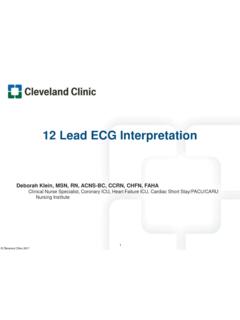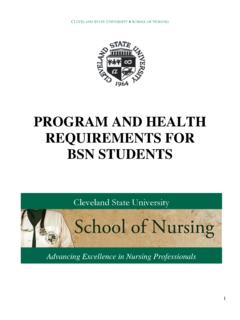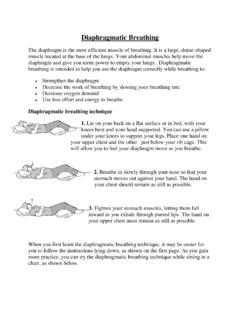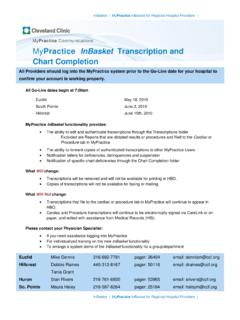Transcription of When patients on warfarin need surgery - Sports @Zunis
1 cleveland clinic JOURNAL OF MEDICINE VOLUME 70 NUMBER 11 NOVEMBER 2003973HE MORE THAN2 million patients inNorth America who take warfarin1facea major problem should they need surgery oran invasive one hand, if they continue taking war-farin up to the time of surgery , they face anincreased risk of bleeding. Therefore, mostpatients need to stop taking warfarin about 5days before surgery the time it takes for itsantithrombotic effect to wear this time and afterward, however,they may be at increased risk of thromboem-bolism, as stopping warfarin may cause arebound hypercoagulable state (which hasbeen described but not validated in clinicalpractice).
2 2 4 Moreover, prolonged immobilityduring surgery and afterward increases the riskfor venous bridge the gap in protection againstthromboembolism, patients can receive heparinin the perioperative period, but questions aboundabout who should receive it, whether to useunfractionated heparin or one of the low-molec-ular-weight heparins, and the optimal this article we discuss: Which surgical procedures can be per-formed without stopping warfarin The optimal times to stop and restart war-farin The use of heparin as a bridge to surgery ,including our recommendations and theprotocol we use at the AnticoagulationClinic of The cleveland SOME PROCEDURES, warfarin CAN BE CONTINUEDA lthough warfarin should be stopped beforemost invasive procedures,5it can be continuedbefore some procedures, as shown by a fewprospective and retrospective studies, casereports.
3 And anecdotal evidence but no ran-domized clinical K. JAFFER, MDMedical Director, The Internal MedicinePreoperative Assessment Consultation andTreatment (IMPACT) Center and theAnticoagulation clinic , Section of Hospitaland Preoperative Medicine, Department ofGeneral Internal Medicine, The ClevelandClinicDANIEL J. BROTMAN, MDSection of Hospital and PreoperativeMedicine, Department of General InternalMedicine, The cleveland ClinicNKEM CHUKWUMERIJE, MDKaiser Permanente Medical Center,Panorama, CAWhen patients on warfarin need surgeryREVIEWnABSTRACTWhen a patient who has been taking warfarin long-termneeds to undergo surgery , how to manage his or heranticoagulation is controversial.
4 We believe most patientsshould stop taking warfarin 5 days before elective surgery ,and most do not need to receive heparin in theperioperative period as a bridge to POINTSSome procedures, such as some ophthalmic, endoscopic,and dermatologic procedures, entail a low risk of bleedingand do not require that warfarin therapy be warfarin is withheld for 5 days, the internationalnormalized ratio usually falls to less than , and surgeryis usually of fresh-frozen plasma or intravenous or oralvitamin K can reverse anticoagulation quickly beforeemergency need for bridging therapy depends on the patient scalculated risk of thromboembolism without it, the risk ofbleeding with it, and other bridging therapy is needed, we use subcutaneousdoses of a low-molecular-weight therapy should usually be restarted on theday after Jaffer has indicated that he has received grant or research support from Astra Zeneca, serves asa consultant for Aventis and Astra Zeneca.
5 And is on the speakers bureau of paper discusses therapies that are experimental or are not approved by the US Food and DrugAdministration for the use under clinic JOURNAL OF MEDICINE VOLUME 70 NUMBER 11 NOVEMBER 2003 Ophthalmic proceduresCataract extractions and trabeculectomies canbe performed without withholding ,6In several small series in which theseprocedures were performed in patients on war-farin therapy,5the rates of retrobulbar hemor-rhage, subconjunctival hemorrhage, and mildhyphema were low, and even when these com-plications occurred, the prognosis was the other hand, the risk of bleeding invitreoretinal, complex lid, lacrimal, andorbital surgical procedures has not been ade-quately studied.
6 Therefore, warfarin should bestopped in these endoscopyGastroenterologists differ widely in what theydo about anticoagulation before ,8In its 2002 guidelines on this topic,9theAmerican Society of GastrointestinalEndoscopy divided endoscopic proceduresinto those that pose a low risk for bleeding(which do not require a change in anticoagu-lation therapy although some doctors mightdisagree10) and those that pose a high bleeding-risk endoscopic proce-dures: Upper endoscopy with or without biopsy Flexible sigmoidoscopy with or withoutbiopsy Colonoscopy with or without biopsy Endoscopic retrograde cannulation of thepancreatic duct without sphincterotomy Biliary stent insertion without sphinctero-tomy Endosonography without fine-needle aspi-ration Push enteroscopy of the small bleeding-risk procedures.
7 Polypectomy Laser ablation and coagulation Endoscopic sphincterotomy Pneumatic or bougie dilation Percutaneous endoscopic gastrostomytube placement Treatment of proceduresNo change in the intensity of anticoagulationis needed before most dental procedures,11eg: Restorations Endodontics Prosthetics Uncomplicated extractions Dental hygiene treatment Periodontal the other hand, warfarin therapy mayneed to be stopped before other proceduressuch as complicated extractions and gingivaland alveolar surgeries. The decision needs tobe made in consultation with the dentist ororal surgeon after determining the risk ofbleeding from the specific dentists give antifibrinolytic agentssuch as tranexamic acid mouthwash to controllocal bleeding without stopping the a small study,13patients who underwentoral surgery used this mouthwash for 2 min-utes four times a day for 1 week afterward.
8 Andnone of them developed postoperative bleed-ing or systemic side proceduresDermatologic procedures that have been per-formed safely without stopping warfarininclude Mohs micrographic surgery and simpleexcisions and prospective study14showed an increase in intraoperative bleedingbut no increase in postoperative more complex procedures (eg, hairtransplantation, blepharoplasty, or facelifts), itmay be necessary to stop warfarin proceduresJoint and soft-tissue aspirations and injectionscan be safely performed without altering oralanticoagulation.
9 In a small study,1525 patientson warfarin underwent 32 procedures withoutany joint or soft-tissue podiatric procedures (eg, nail avul-sions and phenol matrixectomy) can also besafely performed without stopping WARFARINA fter deciding to withhold warfarin preopera-tively, the clinician must decide if the goal isto reverse anticoagulation fully or just todecrease its intensity. Usually, surgery can besafely performed if the international normal-Usually,surgeryis safe if theINR is < ANTICOAGULATIONJAFFER AND COLLEAGUES ized ratio (INR) is lower than etal17found that if the patient s INR is 2 to 3while on warfarin , it almost always falls to lessthan within 115 hours ( days)
10 After thelast our institution, patients take their lastdose of warfarin 5 days before , if the steady-state INR is greaterthan or the patient is elderly, more timemay be required to lower the INR to less Moreover, with neurosurgical proceduresand certain major noncardiac surgeries, near-normal INRs (ie, < ) may be , it is important to routinely checkthe INR immediately before surgery to ensurethat anticoagulation has been anticoagulation quicklybefore emergency surgeryIf the patient needs an emergency procedurewhile his or her INR is in the therapeuticrange, one must reverse the plasmacan reverse antico-agulation immediately without causing anyresistance to warfarin or heparin , it carries the known risks of transfu-sion.








